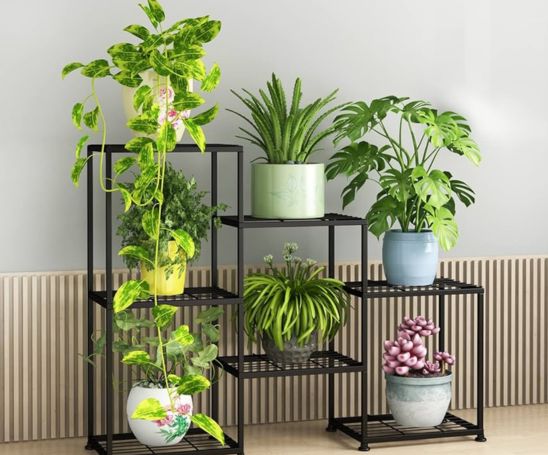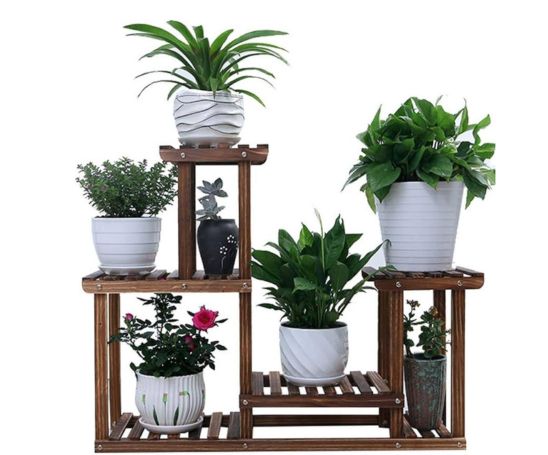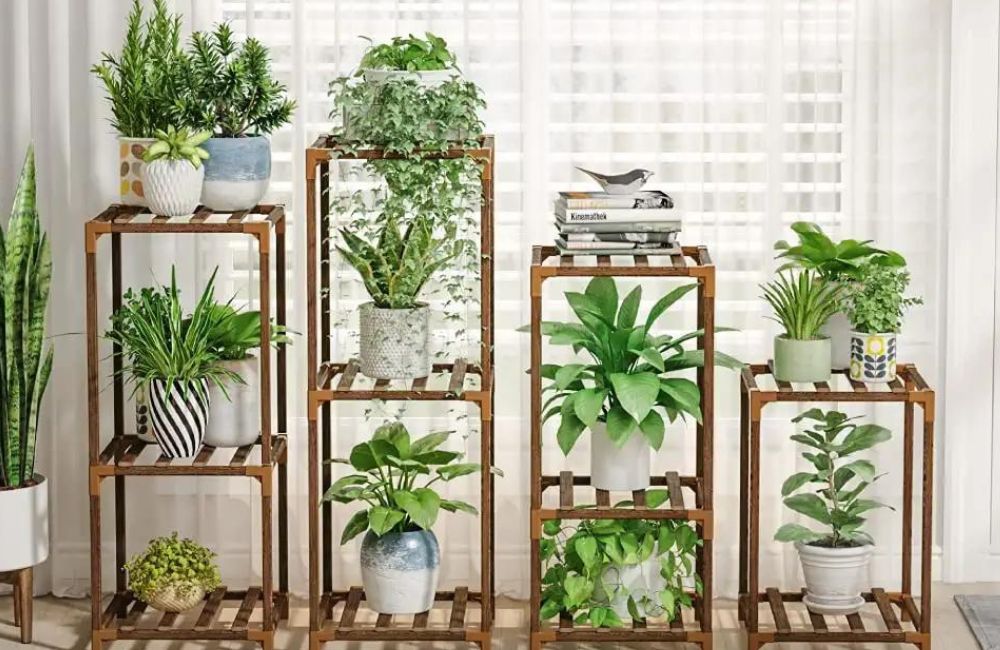A small plant stand indoors could be the answer to your interior design dilemma. Bringing nature indoors and adding life to any space is easy with plants. If you live in a small apartment or have limited floor space, finding the right spot for your plants can be a challenge. The stands vary in shape and size, from simple pillars that hold a single pot to multi-level structures that can display many plants. Several materials can be used in its construction, such as wood, metal, plaster, and plastic. We’ll discuss how to select the ideal size for your small plant stand indoors and provide maintenance and care tips to keep them looking their best.
What is a Small Plant Stand?

A small plant stand is a holder designed to support a potted houseplant, which can be made from various materials such as wood, metal, plaster, or plastic. These stands come in many different shapes and sizes, ranging from simple pillars that hold a single pot to multi-leveled structures capable of displaying many plants. They can be as straightforward or as ornate as desired, complementing the decor of a room and adding beauty as well as functionality. Plant stands can be found in nurseries, home improvement stores, and department stores and are inexpensive home accessory items. They can be used to showcase smaller plants, elevate them to be closer to light sources, or add an aesthetic touch to indoor or outdoor spaces.
Benefits of Having a Small Plant Stand Indoor
Maximizing space, small plant stands to elevate plants for stylish display in confined living spaces. Positioned in corners, tabletops, or shelves, they offer visually appealing arrangements. A practical solution for indoor plant display, these stands combine organization with aesthetics, providing a stylish and organized way to showcase beloved indoor plants. Here are some of the key benefits:
Improved Plant Health
Air circulation and light exposure can be improved by using plant stands. Better air circulation makes it easier for plants to absorb water and nutrients and produce oxygen, thereby improving air quality. Increased light exposure can lead to healthier plant growth.
Space Utilization
Plant stands can help optimize the use of space, especially in small areas. They allow you to display plants vertically, freeing up valuable floor space. This is particularly beneficial in apartments, condos, or other small homes where space is limited.
Enhanced Decor
Plant stands can elevate your home decor by adding a new design element to any room. They can serve as focal points, adding personality and life to a space. Because plant stands can bring plants up to eye level, your plants become more of a feature and focus in your space.
Protection for Plants
Placing plants on stands can protect them from damage by raising them off the ground. Reducing water seepage issues and ensuring enough air circulation under the containers also helps maintain cleanliness.
Versatility
Plant stands come in various shapes, sizes, and materials, making it easy to find one that fits any style or budget. The planters can be customized to create unique arrangements and can display a variety of plant sizes.
Cost-Effective
Plant stands are generally not very expensive, making them a cost-effective way to enhance your indoor garden. Stands can be expensive, depending on the material, but there are options to suit various budgets.
Reduced Clutter
If you’re looking to declutter your small home or office space, using plant stands is a great way to do it. Organizing your belongings and reducing clutter can be achieved with their help.
Types of Small Plant Stand Indoor

Pedestal-style stands offer an elegant display for indoor plants. Tiered stands provide space for many small plants, creating a charming botanical display. Hanging plant stands are ideal for small, trailing plants. Folding stands offer flexibility and easy storage. Adjustable stands adapt to the plant’s size for a secure fit.
Tiered Plant Stands
Tiered bamboo plant stands provide a space-saving solution for showcasing many indoor plants, adding visual interest with their multi-level design. These solid wood stands offer versatility in creating a cohesive plant display and can accommodate plants of varying sizes and heights. Some tiered bamboo plant stands, such as the Ximena 5 Layers 11 Potted Flower Plant Stand Bamboo Wood Storage Organizer Free Standing, show their excellent ability to store and act as a display rack in your home. This irregular five-layer rack is not only practical but also beautiful, making it a perfect addition to your home decor. The surface of the rack is coated with a water-proof coating, ensuring durability and solving any problems that may arise when watering your plants.
Hanging Plant Stands
Hanging plant stands are versatile and can be used to display a variety of plant sizes. Their versatility makes them a flexible option for displaying plants indoors or outdoors. Plants can be hung from ceilings, walls, or other structures, and some designs even have multiple hooks. Small homes, apartments, and condos can benefit from this feature. Hanging plant stands can protect plants from damage by raising them off the ground, away from pets or small children. They can also help maintain cleanliness by reducing water seepage issues. Hanging plant stands are generally relatively inexpensive, making them a cost-effective way to enhance your indoor or outdoor garden.
Corner Plant Stands
Corner plant stands are designed to fit into the corners of a room, making efficient use of space while adding color and life to the area. They can be used indoors or outdoors, making them a flexible option for displaying plants in various settings. Corner plant stands are an excellent way to optimize space, especially in small areas. By fitting into corners, they free up floor or surface space that would otherwise be occupied. Small homes, apartments, and condos can benefit from this feature.
Tabletop Plant Stands
Tabletop plant stands provide a functional and stylish way to showcase small plants, suitable for desks, shelves, or tables. They help bring the beauty of nature indoors in a space-saving manner and are available in a range of designs to complement any decor. These compact and versatile stands offer an easy way to incorporate greenery into small living spaces. Additionally, they can serve dual purposes, such as functioning as an end table in your living room.
Nesting Plant Stands
Nesting plant stands offer versatile options for creating unique plant arrangements, allowing for easy rearrangement to change the display layout. These stylish and space-saving solutions are a versatile addition to any indoor plant display, providing flexibility and functionality. By nesting within each other when not in use, they free up floor or surface space that would otherwise be occupied. Small homes, apartments, and condos can benefit from this feature. They can be found in various materials, including metal, wood, and plastic, and in a range of styles to suit any decor.
Pedestal Plant Stands
Elevating plants to create captivating focal points, pedestal plant stands provide a touch of classic elegance. Available in various heights and materials, they enhance decor while drawing attention to specific plants or pots. These sophisticated stands provide a space-efficient solution for showcasing plants indoors.
Wall-Mounted Plant Shelves
Use vertical space with wall-mounted plant shelves, creating a modern and sleek plant display. Arrange them to personalize your greenery. Free up floor space, adding a touch of nature to your walls. These shelves offer an innovative and space-saving solution for showcasing plants.
How do I Choose A Small Plant Stand Indoor?

Choosing the right plant stand involves considering several factors to ensure that it meets your needs, complements your home decor, and supports the health and growth of your plants. Consider these factors when choosing a plant stand:
Number and Size of Plants
- Total Number of Plants: A stand that can hold multiple plants may be needed if you have multiple plants. Multi-tiered stands are suitable for displaying several plants at once
- Size of the Plants: The stand height should be appropriate for the size of your plants. Tall plants may require shorter stands, while smaller plants can be displayed on multi-level stands to make them more visible.
Home Decor and Style
- Interior Design: Choose a plant stand that matches the style and materials of your home decor. You can opt for a uniform look or mix and match for an eclectic vibe.
- Material: The material of the plant stand should be chosen based on where it will be installed and the overall aesthetic of your space. Material types include wood, metal, glass, and stone.
- Size of the Home: Your plant’s size should determine the height of the stand. For smaller homes, such as apartments, consider space-saving designs like corner stands or hanging stands.
Durability and Stability
Sturdiness: The stand must be sturdy enough to support the weight and prevent tipping, especially for large and heavy plants. Forged and cast iron stands are suitable for larger plants
Weight Capacity: Ensure that the stand can support the weight of your plants and their containers. This is particularly important for stands made of materials like metal, which may have specific weight limitations.
Ease of Maintenance: Consider how easy it will be to maintain the plants on the stand. Stands with an open design allow for better light exposure and air circulation
Grow Lights: If you’re growing plants indoors with limited natural light, you may want to consider stands that can accommodate grow lights.
Budget: Plant stands come in a range of prices. Look for options that provide good value for your budget. Every budget can find a cost-effective option.
Maintenance and Care for Your Small Plant Stand Indoor
Regular maintenance is essential for small plant stand indoor. Dust and wipe wooden stands to maintain their luster. Use gentle, non-abrasive cleaners for metal stands. Protect wooden stands from moisture and sunlight to prevent warping. Incorporate stand maintenance into your plant care routine. Consider the material of the stand when determining the appropriate cleaning method.
Cleaning Tips for Wooden Plant Stands
When cleaning wooden plant stands, use a gentle microfiber fabric for regular dusting. For deeper cleaning, opt for a mild wood cleaner with a damp cloth. Avoid harsh chemicals and abrasive tools to prevent wood damage. Apply wood polish or conditioner to wipe away spills or water to avoid staining or warping the wood.
Preserving the Finish of Metal Plant Stands
Preserving the appearance of metal plant stands is essential for their longevity and appeal. Start by dusting them with a soft, lint-free cloth, and use a cleaner to remove any spots or buildup. Consider applying a protective coating to prevent corrosion and avoid prolonged exposure to moisture. Buff the stand with a dry cloth to restore shine and remove residue.
Frequently Asked Questions
What can I use instead of a plant stand?
Instead of a plant stand, there are several alternatives you can consider. Shelves or bookcases can be used to display your indoor plants. Hanging planters provide a unique and stylish alternative to traditional stands. You can also use decorative baskets or crates for a more rustic look. Get creative and repurpose household items like stools, ladders, or even teacups for unique plant displays.
How do I make a homemade plant stand?
Consider the size and shape based on your plants’ needs.With tools like a saw, drill, and screws, construct your stand. Add a personal touch with paint or stain for a stylish look.
Should indoor plants be on a stand?
Indoor plants can enjoy being elevated on a stand. Small plant stands indoors offer space-saving solutions and add style to your decor. They also promote better air circulation and drainage, protecting floors from water damage. When choosing a stand, consider the size and weight of your plant for stability.
How often should indoor plants be watered?
The frequency of watering indoor plants depends on factors like plant type, size, and environment. Generally, water once a week or when the soil feels dry. Overwatering causes root rot while underwatering leads to dehydration. Observe plants and adjust the watering schedule.
How tall should a plant stand be?
The height of a plant stand should be based on the size of your plant and where you want to place it. Aim to have the top of the plant at eye level or above. Shorter plants may need stands between 12-24 inches tall, while taller plants may need stands over 30 inches. Consider the aesthetic and balance of your space when choosing the height of your plant stand.
Conclusion
Small plant stands indoors not only add a touch of style to your space but also offer practical and space-saving solutions for displaying your beloved plants. Whether you opt for a tiered stand, a hanging stand, or a corner stand, these versatile pieces of furniture provide the perfect platform for your indoor greenery. Additionally, selecting the ideal size for your plant stand is crucial to ensure your plants have enough room to grow and thrive. Regular maintenance and care, such as cleaning wooden stands and preserving the finish of metal stands, will help prolong the lifespan of your plant stand. So, incorporate a small plant stand into your home decor and enjoy the many benefits it brings to your space and your plants.
You may also like SINGLE PLANT STAND INDOOR







